
|

|

|

|

|

|

|

|

|

|

|

|

|

|

|

|

|

|

|

|

|

|

|

|

|

|

|

|

|

|

|

|
|
|
|||||||
| Zoom the game : Windows = Ctrl + or Ctrl - Mac = Cmd + or Cmd - | |||
 |
Gray mouse lemur (Microcebus
murinus)
Gray mouse lemurs are a lemur species found only on
the island of Madagascar. They live in tropical lowland forests along the west
and south coast. With a body length of about 13 centimeters and a weigh of
about 60 grams, they are twice as heavy as Madame Berthe’s mouse lemur, the
smallest living primate in the world. The nocturnal tree dwellers mainly feed
on insects such as beetles, moths, praying mantis but also fruits and nectar. The
males are usually loners while the females form groups especially during
pregnancy and they later jointly raise the offspring. Since the early 1990s, Peter
Kappeler, a behavioral scientist at the DPZ, has done research on the Gray
mouse lemurs at a field station in Kirindy forest in Madagascar.
|
 |
Black capuchin (Sapajus nigritus)
Black capuchin
monkeys belong to the New World monkeys, a primate superfamily that occurs in Central
and South America. The most striking features of Black capuchins are the two
upwardly curved black hair tufts on the head. The medium-sized primates are
diurnal and live in groups of six to twenty animals in southeastern Brazil and
in northeastern Argentina. They are omnivorous but mainly feed on fruits.
Since 1985, DPZ scientists have studied the behavior and ecology of New World monkeys in the research station Estación Biológica Quebrada Blanco in Peru. |
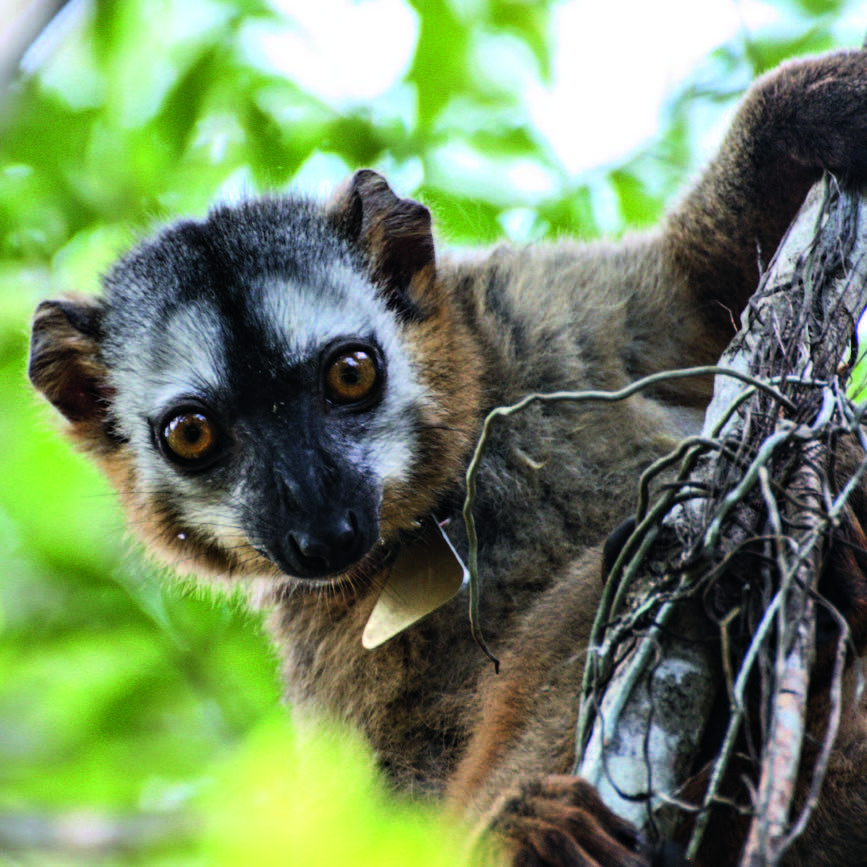 |
Red-fronted lemur (Eulemur
rufifrons) Red-fronted
lemurs live in two separate areas in the southwest and southeast
of the island of Madagascar in lowland and montane forests up to
1700 meters. The animals can reach a length of 40 to 48 centimeters
and weigh up to 2.5 kilogram. Largely diurnal, Red-fronted lemurs
live in groups of about five to 15 animals, which include many males
as well as females and their offspring. Red-fronted lemurs feed
primarily on plant parts such as leaves, bark, juice, stems and
fruits.
|
 |
Rhesus macaque (Macaca
mulatta) Rhesus monkeys are a species of macaques
and belong to the family Cercopithecidae (Old World moneys). They
play an important role in the history of medicine, since the Rhesus
factor was detected in their blood for the first time. Rhesus macaques
live in South, Southeast and East Asia, and exhibit the largest
distribution of all non-human primates. They are diurnal and form
large groups of ten to two hundred animals, composed of many males,
females and juveniles. At the DPZ, Rhesus monkeys are kept in breeding
groups
of different size. Due
to their physiological similarities with humans, they are used in
biomedical and neuroscience
research to study infectious
diseases such as AIDS
or to better understand brain function.
|
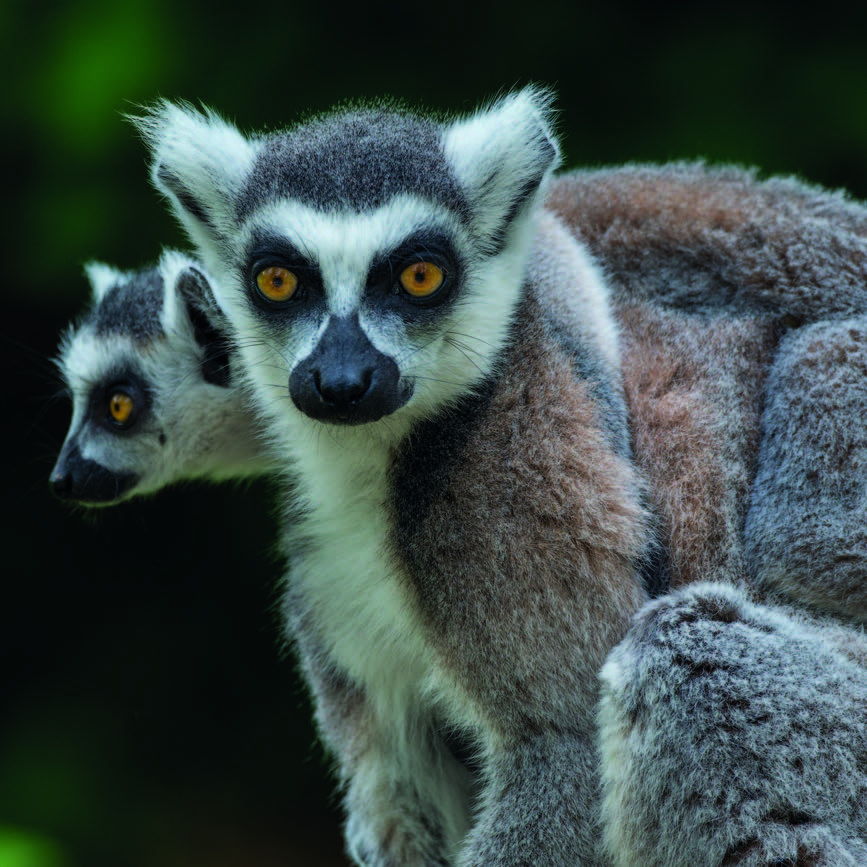 |
Ring-tailed lemur (Lemur
catta)
Ring-tailed lemurs are quite large and easily identifiable by their bushy, ringed tail. They are found in almost the entire south and southwest of Madagascar and because of their ability to adapt easily, they are not as much threatened from extinction as other lemur species. Ring-tailed lemurs live in many different terrain types, from dry forests, thick riparian forests to humid mountain forests. They eat fruits, such as figs, but also bark, leaves, insects and even small vertebrates such as lizards. The lemurs live in groups of six to 20 individuals which include several males and females, and their offspring. DPZ scientists study Ring-tailed lemurs in their native habitat in Madagascar and in captivity. At the DPZ, a group of nine animals is kept in the animal husbandry of the Institute for behavioral research purposes, for example to find out more about their intelligence and cognitive abilities. |
 |
Long-tailed
macaques (Macaca
fascicularis)
Long-tailed
macaques are a species of macaques and belong to the family Cercopithecidae (Old
World moneys). Their typical characteristic is a long tail, which is 40 to 65
centimeters long and therefore longer than the rest of the body. Long-tailed
macaques are found in Southeast Asia. They are diurnal and form large groups of
six to sixty animals, composed of many males, females and juveniles. They
mainly nourish themselves with fruits, but they are also known for their
consumption of crabs and are therefore also called "crab eaters". At
the DPZ Long-tailed macaques are bred and used for cognitive research.
|
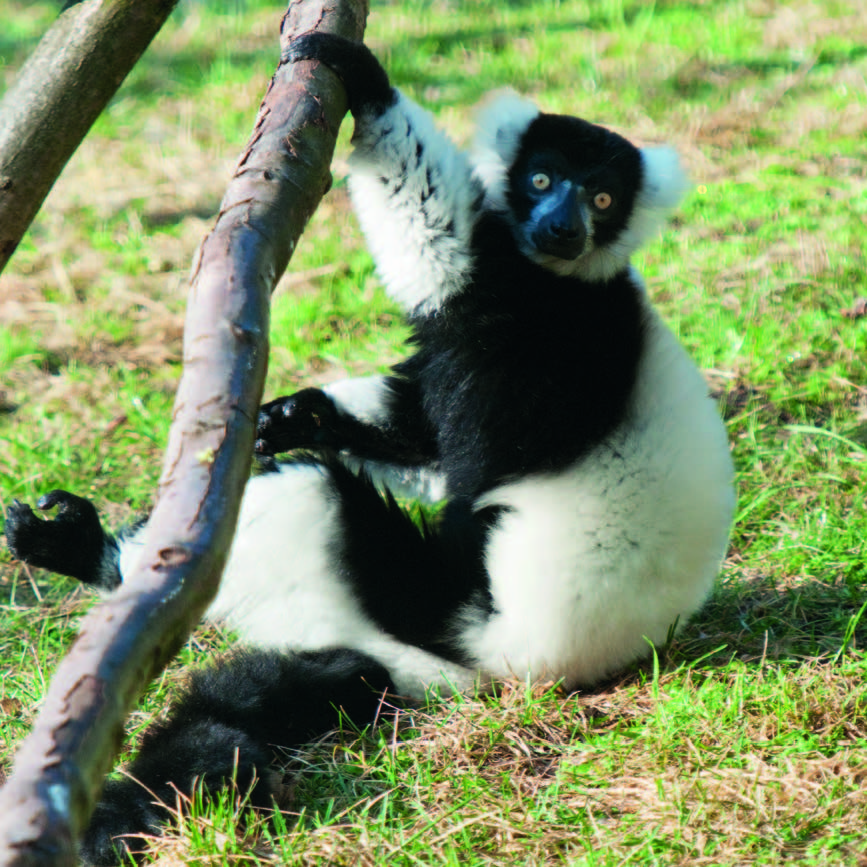 |
Black-and-white ruffed lemur (Varecia variegata)
Black-and-white ruffed lemurs are Malagasy primates which are seriously threatened by extinction. They weigh three to seven kilogram and are relatively large animals which live in very small and scattered areas along the east coast of the island in the humid tropical lowlands, but also in montane forests at altitudes of up to 1300 meters. Their primary nutrition consists of fruits and they are therefore very dependent on fruit trees. Black-and-white ruffed lemurs often live in groups of about 15 animals but if not enough fruit-trees are in the vicinity, the group splits up. They are probably the only lemurs that build nests for birth and rearing their infants. Behavioral researchers of the DPZ are studying a five-member group of these primates at the DPZ in Göttingen. |
 |
Barbary macaque
(Macaca
sylvanus)
Barbary macaques are a species of macaques endemic to the Atlas region of Morocco and Algeria. Their tail is very short. Humans introduced them also to the peninsula Gibraltar, which is the only population of free-living monkeys in Europe. Like all macaques, Barbary macaques live in large groups with twelve to sixty animals. Due to the increasing destruction of their habitat and the illegal pet trade, Barbary macaques are an endangered species. Scientists at the DPZ investigate cognitive skills and social behavior in this species. |
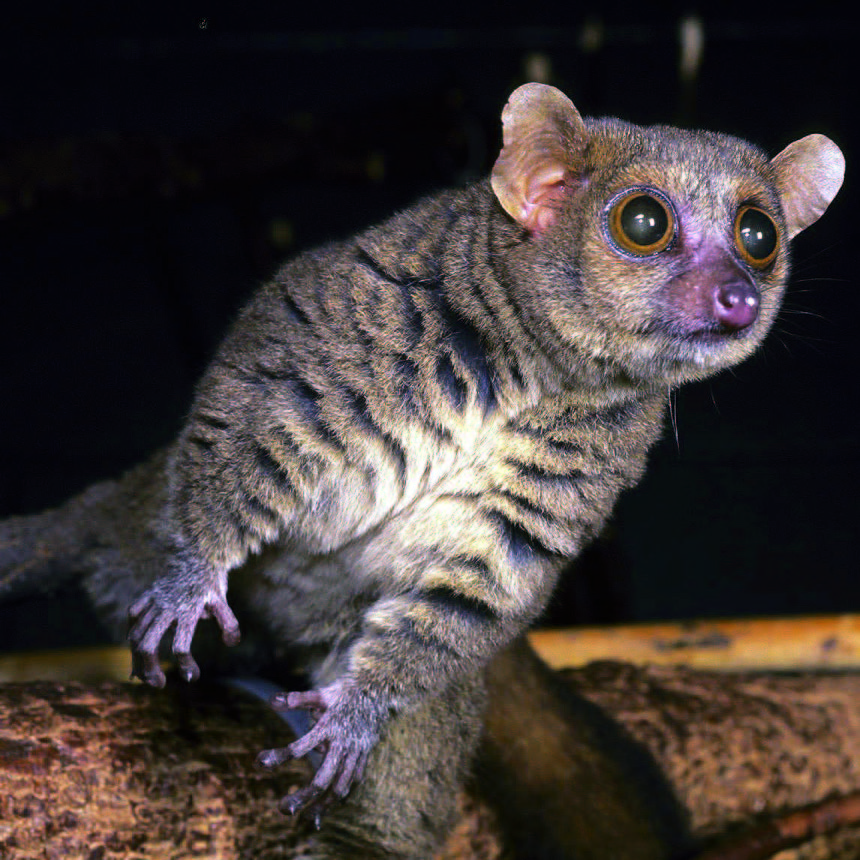 |
Northern giant mouse lemur (Mirza
zaza)
The Northern
giant mouse lemur can be found in the north and northwest Madagascar. They are
about 27 centimeters long and weigh up to 290 grams. Their natural habitat is
diverse and encompasses dry lowland forests, sub-humid transitional forests, gallery
woodlands or even abandoned cashew or banana plantations. The mouse lemurs are
omnivorous, whereby the cashew plays a particularly important role in their
diet. The small primates are nocturnal but during the first half of the night,
they go alone to search of food and during the second part, they take care for
social contacts. It is fairly typical for them to be solitary. The Northern giant
mouse lemur is one of the fourteen species that were newly described by DPZ
scientists.
|
 |
Crested macaque (Macaca nigra)
The macaque’s
name derives from a bristle-like hair formation on the head. Crested macaques
live in the rainforests of the northeastern part of the Indonesian island
Sulawesi. Due to overexploitation and hunting, the species is classified as
endangered. Crested macaques live in groups of up to a hundred animals. Their diet
consists mainly of fruits. Since 2006 DPZ scientists study the ecology,
reproduction and social system of Crested macaques in the Tangkoko Batuangus Nature Reserve near Manado.
|
 |
Sifaka (Propithecus
verreauxi)
The Sifaka is mainly found on the southwestern coast of Madagascar, reaches a body length of up to 48 centimeters and wears a long thick fur. The lemurs are found in almost every imaginable terrain from dry lowland to mountain forests and feed mainly on plant food such as leaves, fruits, flowers and seeds. They are diurnal and live primarily on trees. They have the extraordinary ability to jump on cactus-like Didiereaceae without hurting themselves on the sharp spikes. These large tree dwellers live in small groups with an average of six animals where there are more males than females and the females are the more dominant sex. |
 |
Assam macaque (Macaca
assamensis)
This macaque
species has a large distribution in Asia, from Nepal in the West to Vietnam and
South China in the East. They are mainly found in tropical and subtropical
highland rainforests. The species is diurnal and resides primarily on the
ground. Like all macaques, these monkeys live in large groups with ten to fifty
animals. They are omnivorous and eat mainly plants but also insects and small
vertebrates. Scientists from the University of Göttingen study Assam macaques
at the field station Phu Khieo Wildlife Sanctuary in Thailand since 2005. In 2015, this field station will be operated by
the DPZ in the framework of a joint professorship with the university of
Göttingen.
|
 |
Common marmoset (Callithrix
jacchus)
Common
marmosets can be found in northeastern Brazil. With a body length of 16 to 21 centimeters
they are quite small and thrive very well in different types of forests. They
feed primarily on plant sap, which they suck from stems and vines. The animals
live in groups of three to 13 individuals, of which usually only one mature
couple reproduces. About twice a year the monkeys get offspring of two babies.
They are highly adaptable and thus not directly threatened. Common marmosets
represent the second largest animal colony at the DPZ and are mainly used as
model in biomedical research for example in stem cell, reproductive and
infectious research.
|
 |
Mona monkey (Cercopithecus mona)
The Mona monkey can be found in western Africa from Ghana to Cameroon. The species lives mainly in the middle and upper canopy of the rainforests. The monkeys form groups of five to fifty animals. In smaller groups, there is often only one male. The coat of the Mona monkey ranges from yellowish white over brown to bluish grey. The animals are very frugivorous, but they eat also seeds, flowers, nectare and insects. |
 |
Moustached
tamarin (Saguinus mystax)
Moustached
tamarins live south of the Amazon River in western Brazil and northeastern
Peru. Because they are dependent on a continuous fruit supply, they mainly live
in dense vegetation in the rain forest and are rarely found in parts of the forest
which are regularly flooded. Fruit, supplemented with insects and plant juices,
form the main part of their diet. They usually live in small groups of five to
six individuals, but also groups of up to nine individuals have been observed.
For more than 25 years behavioral biologists from the DPZ have done research on
these monkeys at the field station Quebrada Blanco in Peru.
Recently they could confirm that tamarins play an immensely important role in the distribution of fruit seeds in their ecosystem. |
 |
Guinea baboon
(Papio papio)
Guinea baboons inhabit a small area in northwestern Africa. They live in forests, savannas and steppes and during the day, they are mainly found on the ground. At night, they sleep in trees. Like all baboons, they are omnivorous and primarily feed on seeds, buds, fruits, roots, grass and sometimes insects and vertebrates. They live together in large mixed groups. Since 2007, DPZ scientists investigate the social behavior of the Guinea baboon at the field station Simenti in the Niokolo-Koba National Park in Senegal. Recent studies have shown that in contrast to other baboons, Guinea baboon males show a more cooperative and peaceable behavior among one another. |
 |
Azara's
night monkey (Aotus
azarae)
The Azara’s night monkey is found in large areas in central South America and represents one of the most widespread species of this genus. They can reach a length of up to 35 centimeters and a weight of approximately 1.5 kilogram. As the name indicates, these primates are primarily nocturnal and live in very small groups of two to four individuals, each with a mature male and female. Recently, DPZ scientists have confirmed that Azara’s night monkeys are one of the few mammal species which live genetically monogamous: This means that the male has no descendants with more than one female. They mainly feed on fruits, insects, mushrooms and tree juices and are able to live in a large number of different types of forests. |
 |
Selangor Silvery Langur (Trachypithecus selangorensis)
The Selangor silvery langur is an Asian langur species of the primate subfamily Colobinae. Colobine monkeys are famous for their food specialization. They mainly eat leaves, which are digested in a multi-chambered stomach. The Selangor silvery langur was described as new species by DPZ scientists in 2008. It can be found exclusively on the western shore and mangrove forests of the Malaysian Peninsula. The species is diurnal and lives mostly in trees. The langurs usually live in groups of eleven to thirty-eight animals that include one male and several females. |
 |
Rio Mayo titi (Callicebus
oenanthe)
The Rio Mayo titis are extremely rare primates found
only in a very small area in the northwest of Peru. They are capable of living
in different habitat types, as long as the vegetation has an appropriate
height. In addition to seeds, leaves and flowers, their diet consists mainly of
fruits and arthropods. Rio Mayo titi monkeys are diurnal and live exclusively
on trees. They form small groups of couples who communicate through
extraordinary duet singing, especially in the morning.
Rio Mayo titi monkeys are marked on the red list of threatened species as critically endangered. The individual groups live widely separated in very small isolated habitats. |
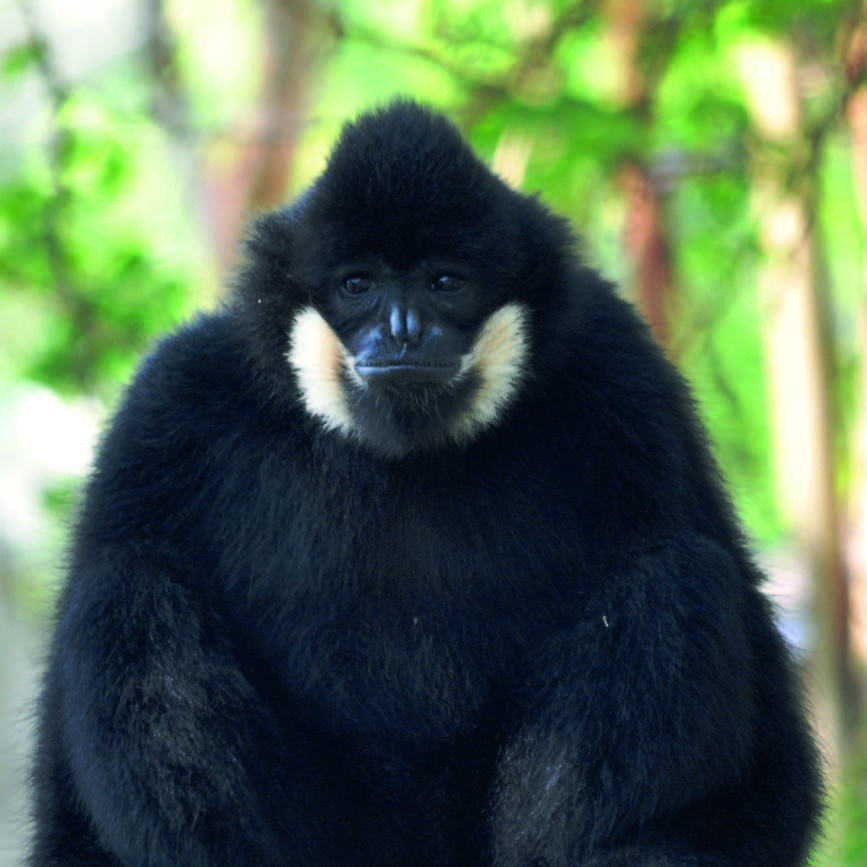 |
Southern white-cheeked gibbon (Nomascus siki)
The Southern white-cheeked gibbon is a species of the crested gibbon genus Nomascus. The species is native to southern Laos and central Vietnam. Both sexes differ significantly in fur coloration. While males have black fur with only white cheeks, the females are yellowish with a black crown patch. They are diurnal tree dwellers and live in pairs. Due to the increasing human-caused habitat loss and the illegal pet trade, they are at great risk. In collaboration with an international team of researchers, DPZ scientists sequenced and investigated the genome of all four gibbon genera in 2014. |